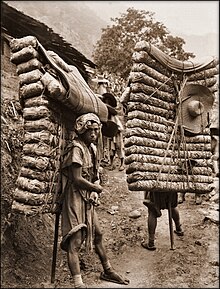Tea routes

The tea routes ( Chinese 茶 古道 , pinyin chágǔdào - "ancient tea route") were historical trade routes that began in southwest China. The goods transported were mainly tea and salt .
There were six major routes with additional alternative routes and branches:
- from Xishuangbanna and Simao (growing area of Pu-Erh tea via Kunming to Beijing ).
- from Pu-erh in Yunnan via Simao, Jinhong, Menghai, Daluo to Burma , from there to Thailand , Singapore , Malaysia and Hong Kong .
- the tea-horse route from Pu-erh via Xiaguan , Lijiang , Zhongdian to Tibet , from there to Lhasa , Nepal and India .
- from Pu-erh via Jiangcheng in Yunnan to Vietnam , from there to Tibet and Europe .
- from Pu-erh via Simao, Lanchang, Meilian in Yunnan to Burma.
- from Pu-erh via Meila in Yunnan to Burma.
The transport by horses, mules , donkeys or on the back of porters took several months. It was almost always carried out in caravans . The road also served as a corridor for migration as well as a channel for communication among ethnic groups in western China; it was also a bridge for cultural and economic exchange between China and India.
These routes appear to have been in use long before the tea trade flourished during the Tang and Song dynasties . Numerous stone box graves from the Shang (approx. 1800–1100 BC) and Zhou dynasties (approx. 1100–256 BC) were found along the routes . Archaeologists have found that the stone boxes discovered in Tibet were closely related to those of Sichuan and Yunnan in terms of shape and funerary objects.
See also
literature
- Xian Yanyun: THE ANCIENT TEA CARAVAN ROUTE. 90 pages, richly illustrated in color, Hong Kong China Tourism Press 1995. ISBN 962779927-0 , OCLC 36832700 (English) - Journey along the tea route